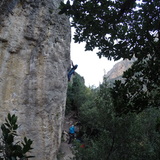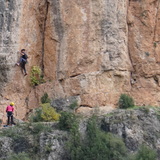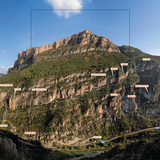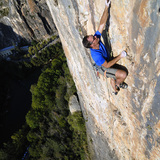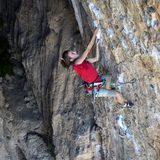Perhaps because of its close proximity to the city of Lleida, Camarasa is one of the longest established sport-climbing zones in the region, with over 35 years of development. The cliffs are spread along the gorge of the River Segre, 3km north of the village and offer pitches up to almost 40m in length on superb rough limestone, generally vertical or slightly overhanging. The climbing is technical and athletic, and thanks to the profusion of positive edges and sharp pockets, rock which looks prohibitively difficult from below can often be climbed at surprisingly reasonable grades. Until fairly recently Camarasa’s main claim to fame was as a warm-weather retreat, the northwesterly orientation of the majority of its sectors providing much needed respite during the scorching hot days of summer. However, during the last few years, the development of several outstanding sectors on the sunny side of the gorge now means that Camarasa is a true all-season venue.
🙋🏽♀️Note: fog can be a problem here in December and early January!
Note: after the recent closure of the access road to the Hydroelectric plant to all but essential personnel, the 'old' parking areas P1-P4 are no longer available. It is now necessary to park at the head of the access road, next to the Pont del Pastor road bridge (the 'new' P1). If this is full, drive across the bridge and continue uphill for approximately 350m to a very large parking area on the right (the 'new' P2). Of course, this means a considerable amount of extra walking — between 10 and 20 minutes (albeit flat) to reach these sectors.
🧗♂️Kuestelon la France
An extensive sector containing a good number of 6th and 7th grade climbs, as well as some of the hardest routes in Camarasa. Kuestelon was one of the first crags to be equipped in this zone and some of the grading can be distinctly ‘old school’.
🚶♂️
Approach: From P1, next to the Pont del Pastor road bridge, pass the metal barrier and walk along the access road (actually named in honour of Ronald Reagan!) for approximately 1.2km to reach a cleared area on the left-hand side of the road (actually the 'old' P1). Opposite this, a steep, narrow path leads up the hillside towards the cliffs. After approximately 40m a junction of paths is reached: turn right and continue horizontally for about 25m before heading up and left to the base of the base of the crag (15 minutes from P1). The path reaches the crag just left of centre of the sector. Turn left to access the first 30 routes, or right to access all other routes.
Note: the far left-hand side of the crag can also be reached from the path leading up to sector La Blanca (see below) and this is slightly quicker than the ‘normal’ way.
Orientation: northwest — shade until mid/late afternoon.
🧗♂️La Blanca + Sector Emotion
Two very interesting sectors with some excellent routes.
🚶♂️
Approach: From P1, next to the Pont del Pastor road bridge, pass the metal barrier and walk along the access road (actually named in honour of Ronald Reagan!) for approximately 1.2km to reach a cleared area on the left-hand side of the road (actually the 'old' P1). Opposite this, a steep, narrow path leads up the hillside towards the cliffs. After approximately 40m a junction of paths is reached. Go left here (the right fork leads to Kuestelon La France) and continue up a narrow trail leading to the base of the right-and part of La Blanca (18 minutes from P1). The left-hand part of La Blanca is some 20m to the left. Sector Emotion is located higher up the hillside to the right.
Orientation: generally northwest (shade until mid/late afternoon) but parts of the sector face due north and receive no sun at all.
🧗♂️San Juan
A small, roadside sector offering some short routes.
🚶♂️
Approach: From P1, next to the Pont del Pastor road bridge, pass the metal barrier and walk along the access road for approximately 1.5km to reach the base of the sector (18 minutes from P1). Note: there is a fresh water spring situated just above the river (just below the sector) and reached by scrambling down a well-marked path below the road.
Orientation: northwest — shade until mid-afternoon.
🧗♂️Marcant Estil
This long, roadside sector is almost certainly the most popular in Camarasa. The minimal approach is part of the reason for that, but the large number of lower grade climbs on offer here is also a contributing factor (although the grading on many of these is rather stiff…). Some climbers actually park directly below the sector (instead of in P2) but this invariably causes problems for through traffic, especially at busy times, and is not recommended.
🚶♂️
Approach: From P1, next to the Pont del Pastor road bridge, pass the metal barrier and walk along the access road for approximately 1.7km, passing San Juan, to reach the base of the sector (20 minutes from P1). Orientation: northwest — shade until mid-afternoon.
🧗♂️La Font
A nice sector with some excellent routes. ‘Font Picant’ is regarded as the classic Camarasa 8a.
🚶♂️
Approach: From the right-hand side of Marcant Estil, follow a vague path up and right, crossing a large rockfall scar. There are fixed ropes on some of the steeper sections. On nearing the cliffs the path splits: for routes on the left-hand part of the sector continue straight up (8 minutes). Fixed ropes (in poor condition) give access to a spacious ledge below the left-hand routes.(25 minutes from P1). More fixed ropes give access to a belay below the next group of routes. For the right-hand side of the sector: where the path splits follow a vague path down and rightwards before heading straight up (fixed ropes in place) to the base of the wall (28 minutes from P1). Not recommended for dogs or non-climbers. The final 4 routes are situated up and right of the main sector on a piece of rock known as 'El Libro' (The Book). To reach this, continue rightwards from the final route on the main sector to where fixed ropes enable steep rock to be climbed (extremely exposed — be sure to wear a harness and clip in!) to a belay area below the routes. More fixed ropes help overcome the first vegetated metres of the routes on this sector, above which the rock is excellent.
Orientation: northwest — shade until mid/late-afternoon.
🧗♂️El Perrancot
A micro-sector with just a few short routes. Old school grading!
🚶♂️
Approach: Just after passing sector Marcant Estil, turn sharply right and follow a well-marked path diagonally rightwards for approximately 50m to reach the micro-sector of El Perrancot (25 minutes from P1).
Orientation: northwest — shade until mid/late-afternoon.
🧗♂️La Pera
A superb sector featuring a number of excellent 6th grade climbs on beautiful rock. A large twin-summited pinnacle lies a few metres in front of the main section of cliff and the climbs can be found on the rear side of the pinnacle as well as on the main cliff immediately behind.
🚶♂️
Approach: Just after passing sector Marcant Estil, turn sharply right and follow a well-marked path diagonally rightwards. Pass the micro-sector of El Perrancot after 50m and then continue up the track for a further 50m to where a path branches off to the left (iron rung in a rock-step where it starts). Follow the path uphill, zigzagging between two electricity pylons before heading rightwards below twin pinnacles (the front face of La Pera). Immediately after passing the pinnacles a side-path heads up and left, leading into the gap between the pinnacles and the main wall. This is the sector (30 minutes from P1).
Orientation: La Pera is an ‘internal’ sector, which makes the orientation somewhat irrelevant. Suffice to say that, apart from a couple of hours around midday/early afternoon, when the sun is directly overhead (and even then it doesn’t reach certain routes) there is always plenty of shade.
🧗♂️Paret dels Heretges
These high walls offer only a few routes and the best climbing is found on the upper sections of the cliff, meaning you have to do a first pitch to get to where it starts. This seems to put many people off but it shouldn’t — those upper pitches are generally superb and the exposure beats anything else in Camarasa.
🚶♂️
Approach: Just after passing sector Marcant Estil, turn sharply right and follow a well-marked path diagonally rightwards. Pass the micro-sector of El Perrancot after 50m and then continue up the track for a further 50m to where a path branches off to the left (iron rung in a rock-step where it starts). Follow the path uphill, heading towards La Pera, but instead of reaching that sector continue going leftwards along the base of the cliffs for approximately 40m to reach the first routes on the right-hand side of the sector (30 minutes from P1).
Orientation: northwest — shade until mid/late-afternoon.
🧗♂️Cingle de la Llum
A very nice sector with some excellent 6th and 7th grade routes.
🚶♂️
Approach: Just after passing sector Marcant Estil, turn sharply right and follow a well-marked path diagonally rightwards. Pass the micro-sector of El Perrancot after 50m and then continue up the track for a further 50m to where a path branches off to the left (iron rung in a rock-step where it starts). Follow the path uphill, zigzagging between two electricity pylons before heading rightwards below twin pinnacles (the front face of sector La Pera). Cingle de La Llum is situated just to the right of La Pera — continue rightwards along the main path for 30m before turning left onto a side-path. Follow this, passing an electricity pylon, up to the base of the left-hand side of the sector (32 minutes from p1).
Orientation: northwest — shade until mid/late-afternoon. The sun touches the left-hand side of the sector around 1’ or 1’30” before it reaches the right.
🧗♂️Capricho de Vicho
This is another of Camarasa’s older sectors and features some very hard ‘old school’ routes. However, the more recent addition of a number of climbs in the 6th and 7th grades also makes it well worth a visit for ‘normal’ climbers.
🚶♂️
Approach: Just after passing sector Marcant Estil, turn sharply right and follow a well-marked path diagonally rightwards. Pass the micro-sector of El Perrancot after 50m and then continue up the track for a further 50m to where a path branches off to the left (iron rung in a rock-step where it starts). Follow the path uphill, zigzagging between two electricity pylons before heading rightwards below twin pinnacles (the front face of La Pera). Pass Cingles de La Llum to reach the left hand side of the sector (35 minutes from P1). This sector is split into two sections, left and right. Routes 1-16 are situated on the first section of rock, while routes 17-27 lay on a separate wall some 50m further right. Orientation: northwest — shade until mid/late-afternoon.
🧗♂️Sector Dexter
Although this was one of the last sectors on Camarasa’s upper-tier to be developed it offers some really nice routes in the 5th and 6th grades. ‘Gòtic’ (V+) is a fantastic crack/diedre and one of the best climbs at its grade in Camarasa.
🚶♂️
Approach: just after passing the left-most climbs of sector Marcant Estil. From here walk a few metres down the road towards the Hydroelectric plant then turn sharply right and follow a well-marked path diagonally rightwards. Pass the micro-sector of El Perrancot after 50m and then continue up the track for a further 50m to where a path branches off to the left (iron rung in a rock-step where it starts). Follow the path uphill, zigzagging between two electricity pylons before heading rightwards below twin pinnacles (the front face of sector La Pera). Keep on the main path, passing sectors La Pera, Cingle de La Llum and Capricho de Vicho. The first routes of Sector Dexter are situated just to the right of the final routes of Capricho de Vicho (37 minutes from P1).
Note: Routes 16-19 are situated some 30m to the right of the main part of the sector.
Orientation: northwest — shade until late-afternoon.
🧗♂️Sector Fashion
this smooth, vertical wall is the epitome of climbing in Camarasa, offering steep, athletic routes that are guaranteed to leave a smile on your face.
🚶♂️
Approach: just after passing the left-most climbs of sector Marcant Estil. From here walk a few metres down the road towards the Hydroelectric plant then turn sharply right and follow a well-marked path diagonally rightwards. Pass the micro-sector of El Perrancot after 50m and then continue up the track for a further 50m to where a path branches off to the left (iron rung in a rock-step where it starts). Follow the path uphill, zigzagging between two electricity pylons before heading rightwards below twin pinnacles (the front face of sector La Pera). Keep on the main path, passing sectors La Pera, Cingle de La Llum, Capricho de Vicho and Dexter. Sector Fashion is located approximately 80m right of Sector Dexter (40 minutes from P1).
Note: the final few metres of approach cross a steep wall furnished with fixed ropes and iron rungs. This is not recommended for dogs, non-climbers or small children.
Orientation: northwest — shade until mid/late-afternoon.
🧗♂️La Selva
This is the final sector on the upper-tier of cliffs in Camarasa and also probably the best. The grades run from 5b to 8a+ and some of the routes reach 35m in height.
🚶♂️
Approach: just after passing the left-most climbs of sector Marcant Estil. From here walk a few metres down the road towards the Hydroelectric plant then turn sharply right and follow a well-marked path diagonally rightwards. Pass the micro-sector of El Perrancot after 50m and then continue up the track for a further 50m to where a path branches off to the left (iron rung in a rock-step where it starts). Follow the path uphill, zigzagging between two electricity pylons before heading rightwards below twin pinnacles (the front face of sector La Pera). Keep on the main path, passing sectors La Pera, Cingle de La Llum, Capricho de Vicho, Dexter and Fashion. La Selva is located approximately 200m right of Sector Fashion (45 minutes from P1). The first few climbs are found on a steep wall, but the main part of the sector lies further to the right and is accessed by first descending a short ‘via ferrata’ and then scrambling up to the base of an impressive cave .
Orientation: generally northwest (shade until mid/late-afternoon) but parts of the sector never see any sun at all. Note: the necessity of negotiating the ‘via ferrata’ when passing Sector Fashion means the approach to La Selva cannot be recommended for non-climbers or those with children and/or dogs.
🧗♂️El Puro
This fine pinnacle has some ‘classic’ (not equipped) multi-pitch climbs as well as some multi and single-pitch bolted routes.
🚶♂️
Approach: From P1 follow the access road until 30m before reaching the gates of the Hydroelectric plant. Here, a steep path (green paint mark on a tree) leads up through the trees to the base of the large pinnacle (30 minutes from P1).
Orientation: northwest — shade until late-afternoon.
🧗♂️El Balcó del Mu:
This small but excellent sector lies in the canyon between Camarasa and Alòs de Balaguer. The routes are short but action-packed.
🚶♂️
Approach: From P1 walk along the the access road to where it ends then follow a spectacular, but safe, metal walkway suspended above a dammed section of the River Segre. Continue along the well-marked footpath following signs to Alòs de Balaguer, crossing the river via a wooden bridge. Approximately 300m after the bridge the main path turns sharply leftwards: there is a signpost warning of Risc de Caigudes (Danger of falling) on the apex of the bend. Here turn right and follow a reasonably well-marked trail contouring across the hillside above the river. Approximately 500m from the Risc de Caigudes signpost the path leads up and left, ascending a short steep gully (fixed rope) then back rightwards to a splendid ‘balcony’ immediately below the sector (40 minutes from P1).
Orientation: south. Note: although this sector faces almost due south, the narrowness and depth of the gorge at this point prevents the low winter sun from reaching the wall completely from early November until late February, meaning the only viable months to climb here are September/October and March/April.
